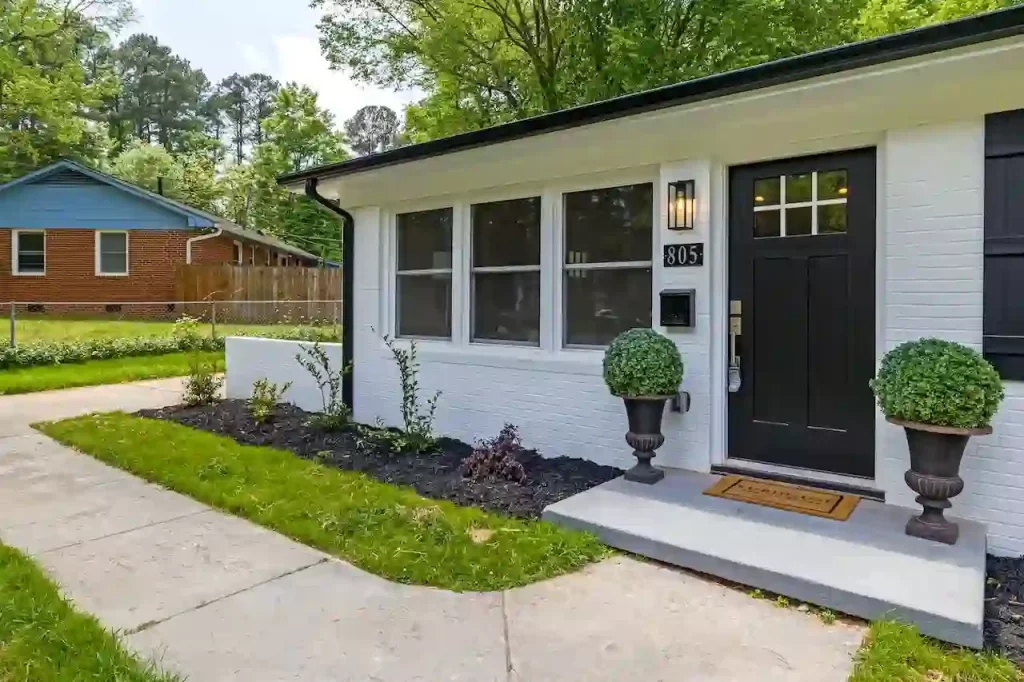Before starting any landscaping project, it’s crucial to plan ahead and establish a budget. This will help you stay on track financially and prevent overspending. By taking the time to plan and budget, you can also prioritize the most important aspects of your landscaping project and avoid unnecessary expenses.
To create a landscaping plan that fits your budget, start by identifying your needs and goals. Consider factors such as the size of your yard, the amount of maintenance you’re willing to do, and any specific features you want to include. Once you have a clear idea of what you want, research and compare prices for materials and services to get an estimate of the costs.
As you plan your landscaping project, be sure to include room for unexpected expenses or changes. It’s also a good idea to break down the project into smaller, more manageable phases to spread out the cost over time.
Finally, don’t forget to track your expenses as you go along. This will help you stay within your budget and make adjustments as needed. With a little bit of planning and budgeting, you can create a beautiful outdoor space that fits your needs and your wallet.
Choose Low-Maintenance Plants
Choosing low-maintenance plants can help you save money on your landscaping projects by reducing the amount of water, fertilizer, and maintenance required. Additionally, low-maintenance plants are often more resistant to pests and diseases, which can further reduce the need for costly treatments.
When selecting plants for your landscaping project, look for options that are native to your region or that are well adapted to your climate. These plants will require less water and maintenance than non-native species, which can save you both time and money.
In addition to choosing the right type of plants, consider the specific needs of each plant. Some plants require more water or sunlight than others, so be sure to group them accordingly. This will help ensure that each plant receives the optimal conditions it needs to thrive, which can also reduce the amount of maintenance required.
Finally, consider using groundcovers and other low-maintenance landscaping features to reduce the need for water and maintenance. Groundcovers such as mulch, gravel, and grasses can help retain moisture and prevent weed growth, which can save you time and money in the long run. By selecting low-maintenance plants and landscaping features, you can create a beautiful outdoor space while minimizing costs and effort.
Buy Plants at the Right Time
Buying plants during the off-season is a great way to save money on your landscaping project. Nurseries and garden centers often discount their prices during the off-season, making it a great time to stock up on plants at a lower cost.
In addition to buying plants at the right time of year, it’s also important to choose the right time to plant. Planting at the wrong time can result in plant stress or even death, which can be a costly mistake.
As a general rule, it’s best to plant trees, shrubs, and perennials in the spring or fall, when temperatures are mild and there is adequate rainfall. This allows the plants to establish their roots before the heat of summer or the cold of winter sets in.
When buying plants during the off-season, be sure to inspect them carefully for signs of damage or disease. It’s also a good idea to research the specific planting requirements for each type of plant to ensure that you are giving it the best possible chance to thrive.
By buying plants at the right time and planting them at the right time of year, you can save money on your landscaping project while ensuring that your plants have the best possible chance to grow and thrive.
Use Recycled Materials
Using recycled materials in your landscaping projects can help you save money while also reducing waste and supporting sustainability. Recycled materials can be used in a variety of ways, from creating pathways and retaining walls to building planters and garden structures.
One of the easiest ways to incorporate recycled materials into your landscaping is to use mulch made from recycled wood chips or yard waste. This can be a cost-effective alternative to traditional mulch, while also reducing the amount of waste that ends up in landfills.
Another option is to use recycled pavers or bricks for pathways or patios. These materials can often be found at salvage yards or home improvement stores at a fraction of the cost of new materials. You can also use recycled concrete or stone for retaining walls or garden borders.
For a more creative touch, consider using recycled materials to build garden structures such as trellises or garden art. Old metal fencing, wire mesh, and even old bicycle wheels can be repurposed into unique and functional garden features.
By incorporating recycled materials into your landscaping projects, you can save money while also reducing waste and supporting sustainability. Be creative and look for opportunities to repurpose items that might otherwise end up in the landfill.
DIY Projects
DIY landscaping projects can be a great way to save money on your landscaping while also giving you a sense of satisfaction and accomplishment. When done properly, DIY projects can be just as effective and visually appealing as those done by professionals.
One of the biggest advantages of DIY landscaping is the cost savings. By doing the work yourself, you can avoid paying for labor costs and save money on materials by shopping around for deals and using recycled materials.
Before starting any DIY landscaping project, it’s important to plan ahead and understand your own skill level. Start with small projects such as planting flowers or building a small garden bed before tackling larger projects such as installing a patio or building a retaining wall.
It’s also important to have the right tools and equipment on hand before starting any DIY project. This can include everything from shovels and rakes to power tools such as saws and drills.
If you’re not sure where to start with a DIY landscaping project, there are plenty of resources available online or in books that can provide inspiration and step-by-step instructions.
By taking on DIY landscaping projects, you can save money and gain a sense of satisfaction from creating something beautiful and functional in your own backyard. Just be sure to plan ahead and understand your own skill level before starting any project.
Repurpose Existing Landscaping Features
Repurposing existing landscaping features is another great way to save money on your landscaping projects. It not only reduces the amount of waste but also adds a unique touch to your landscaping design.
One way to repurpose existing features is to use materials from old structures such as bricks or stones to create new garden beds or walkways. You can also use old containers or planters to create a unique focal point in your garden.
Another way to repurpose existing landscaping features is to give them a new purpose. For example, an old fountain can be converted into a planter or a bird bath. You can also turn an old tree stump into a small seating area or a decorative element by painting it or adding a plant on top.
Repurposing existing features can also be a way to bring new life to a tired landscaping design. For example, you can turn an old patio into a new seating area by adding new furniture and plants or by creating a new focal point such as a fire pit or water feature.
When repurposing existing landscaping features, it’s important to think creatively and consider the possibilities. With a little imagination and effort, you can create a unique and cost-effective landscaping design that reflects your personal style and taste.
Hire a Landscaping Professional
While DIY landscaping projects can save you money, sometimes it’s best to hire a professional landscaper, especially for more complex projects. A professional landscaper can help you create a cohesive and well-designed outdoor space that meets your needs and fits your budget.
One of the benefits of working with a professional landscaper is their expertise and knowledge. They can help you choose the right plants, materials, and design elements for your specific climate, soil, and sun exposure. They can also offer advice on the best maintenance practices to keep your landscaping looking its best.
Another advantage of hiring a professional landscaper is that they have the right tools and equipment to get the job done efficiently and effectively. They also have access to wholesale nurseries and suppliers, which can result in cost savings for you.
To find a landscaper that fits your budget, do your research and get multiple quotes from different companies. Ask for references and check their reviews online. Look for landscapers who are licensed and insured, and who have experience working on projects similar to yours.
Working with a professional landscaper may be more expensive upfront, but it can save you time, money, and headaches in the long run. By finding a landscaper that fits your budget, you can create a beautiful and functional outdoor space that adds value to your home and enhances your quality of life.
Maintain Your Landscaping
Maintaining your landscaping is essential to ensuring that it stays healthy, vibrant, and beautiful. Proper maintenance can also prevent costly problems down the road, such as plant diseases or overgrown trees and shrubs.
One of the most important aspects of landscaping maintenance is regular watering. Make sure to water your plants deeply and infrequently to encourage deep root growth. If you have a large lawn, consider installing a sprinkler system to save time and ensure even watering.
Another important maintenance task is pruning and trimming your plants. Regular pruning can help promote healthy growth and prevent the spread of disease. Additionally, trimming overgrown trees and shrubs can help maintain a neat and tidy appearance while preventing potential safety hazards.
Fertilizing is another key aspect of landscaping maintenance. Adding the right nutrients to your soil can help keep your plants healthy and vibrant. Consider using organic fertilizers or compost to promote healthy soil and reduce the use of harmful chemicals.
Finally, regular clean-up is crucial for maintaining your landscaping. Remove dead leaves, branches, and debris regularly to prevent them from piling up and attracting pests. By keeping your landscaping tidy and well-maintained, you can ensure that it continues to thrive for years to come.
Conclusion
In conclusion, home landscaping is an essential part of creating a beautiful and welcoming outdoor space. However, it can also be an expensive undertaking. By implementing these 10 tips, you can save money on your landscaping projects without sacrificing quality or beauty.
First, plan ahead and set a budget. Next, choose low-maintenance plants and buy them at the right time. You can also use recycled materials, tackle DIY projects, and repurpose existing features to save money.
If you need professional help, make sure to choose a landscaper that fits your budget. And once your landscaping is complete, regular maintenance can help keep it healthy and vibrant.
Don’t let cost hold you back from creating the outdoor space of your dreams. With a little creativity and effort, you can achieve stunning results while staying within your budget. So take action and start your landscaping projects with confidence today!





